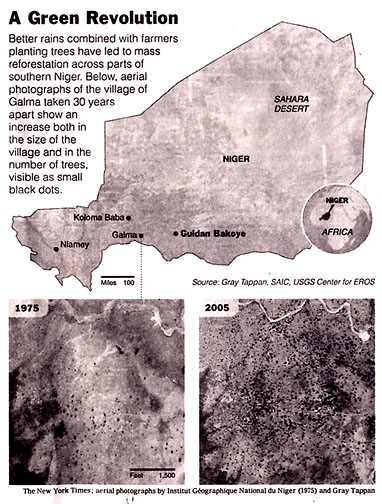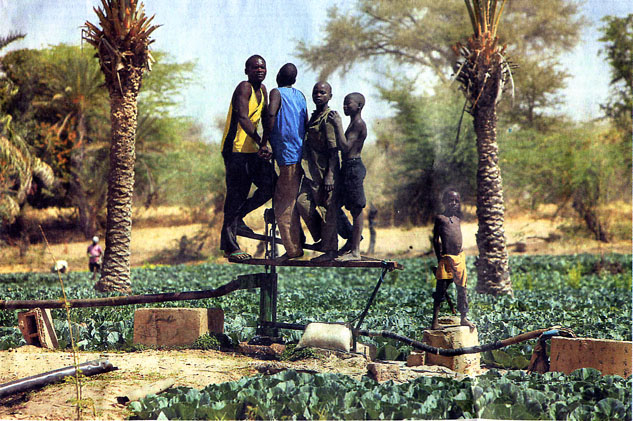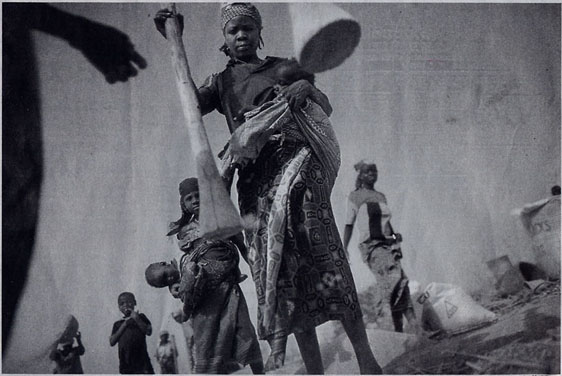|
In Niger farmers are
saving trees to protect the land from erosion and to sell tree products, and
thus reclaiming farm land from the desert.
Beginning in the mid-80's,
following years of drought and population growth, farmers in Niger began to
plow and plant around trees, rather than clearing them as in the past. This
gave farmers branches for fire wood, pods for animal feed and fruit that can
all be sold or used at home. The trees' roots fix the soil in place,
preventing it from being carried off with the wind and preserving farmable
land. The roots also help hold water in the ground, rather than letting it
run off across rocky, barren fields into gullies where it floods villages
and destroys crops. The roots of some trees also deliver nitrogen,
with fertilizing properties, to the soil. And the leaves become fertilizer
after they fall to the ground....A factor in tree conservation has been a
change in the law, which, since colonial times, had defined trees as state
property. The government of Niger, an area twice the size of the state of
Texas, lacked means to protect trees against harvesting for construction and
firewood. With the emergence of the concept that people owned trees on their
land and in their communities, people began to appreciate the advantages of
preserving trees....In one village a group of widows puts manure in pits they
have dug in barren soil. Rainwater carries the manure into the surrounding
soil, reclaiming the land for farming....These successes have come from the
local people working together, not from international aid groups'
management.
|
|
 |
| |
|
|
In
Niger, Trees and Crops Turn Back the Desert
By Lydia Polgreen
New York Times, Feb. 11, 2007
Full Text :COPYRIGHT 2007 The New
York Times Company
In this dust-choked region, long seen as an increasingly barren wasteland
decaying into desert, millions of trees are flourishing, thanks in part to poor
farmers whose simple methods cost little or nothing at all.
Better conservation and improved rainfall have led to at least 7.4 million
newly tree-covered acres in Niger, researchers have found, achieved largely
without relying on the large-scale planting of trees or other expensive methods
often advocated by African politicians and aid groups for halting
desertification, the process by which soil loses its fertility.
Recent studies of vegetation patterns, based on detailed satellite images and
on-the-ground inventories of trees, have found that Niger, a place of persistent
hunger and deprivation, has recently added millions of new trees and is now far
greener than it was 30 years ago.
These gains, moreover, have come at a time when the population of Niger has
exploded, confounding the conventional wisdom that population growth leads to
the loss of trees and accelerates land degradation, scientists studying Niger
say.
The vegetation is densest, researchers have found, in some of the most
densely populated regions of the country.
''The general picture of the Sahel is much less bleak than we tend to
assume,'' said Chris P. Reij, a soil conservationist who has been working in the
region for more than 30 years and helped lead a study published last summer on
Niger's vegetation patterns. ''Niger was for us an enormous surprise.''
About 20 years ago, farmers like Ibrahim Danjimo realized something terrible
was happening to their fields.
''We look around, all the trees were far from the village,'' said Mr. Danjimo,
a farmer in his 40s who has been working the rocky, sandy soil of this tiny
village since he was a child. ''Suddenly, the trees were all gone.''
Fierce winds were carrying off the topsoil of their once-productive land.
Sand dunes threatened to swallow huts. Wells ran dry. Across the Sahel, a
semiarid belt that spans Africa just below the Sahara and is home to some of the
poorest people on earth, a cataclysm was unfolding.
Severe drought in the 1970s and '80s, coupled with a population explosion and
destructive farming and livestock practices, was denuding vast swaths of land.
The desert seemed determined to swallow everything. So Mr. Danjimo and other
farmers in Guidan Bakoye took a small but radical step. No longer would they
clear the saplings from their fields before planting, as they had for
generations. Instead they would protect and nurture them, carefully plowing
around them when sowing millet, sorghum, peanuts and beans.
Today, the success in growing new trees suggests that the harm to much of the
Sahel may not have been permanent, but a temporary loss of fertility. The
evidence, scientists say, demonstrates how relatively small changes in human
behavior can transform the regional ecology, restoring its biodiversity and
productivity.
| |
 |
|
| |
In Ague, Niger, where replanting trees helped
alleviate the effects of a famine, young men and boys operate a foot pump to
draw water for irrigation. (Photo by Michael Kamber for NYT's) |
|
In Niger's case, farmers began protecting trees just as rainfall levels began
to rise again after the droughts in the 1970s and '80s.
Another change was the way trees were regarded by law. From colonial
times, all trees in Niger had been regarded as the property of the state, which
gave farmers little incentive to protect them. Trees were chopped for firewood
or construction without regard to the environmental costs. Government foresters
were supposed to make sure the trees were properly managed, but there were not
enough of them to police a country nearly twice the size of Texas.
But over time, farmers began to regard the trees in their fields as their
property, and in recent years the government has recognized the benefits of that
outlook by allowing individuals to own trees. Farmers make money from the trees
by selling branches, pods, fruit and bark. Because those sales are more
lucrative over time than simply chopping down the tree for firewood, the farmers
preserve them.
The greening began in the mid-1980s, Dr. Reij said, ''and every time we
went back to Niger, the scale increased.''
''The density is so spectacular,'' he said.
Mahamane Larwanou, a forestry expert at the University of Niamey in Niger's
capital, said the regrowth of trees had transformed rural life in Niger.
''The benefits are so many it is really astonishing,'' Dr. Larwanou said.
''The farmers can sell the branches for money. They can feed the pods as fodder
to their animals. They can sell or eat the leaves. They can sell and eat the
fruits. Trees are so valuable to farmers, so they protect them.''
They also have extraordinary ecological benefits. Their roots fix the soil
in place, preventing it from being carried off with the fierce Sahelian winds
and preserving arable land. The roots also help hold water in the ground, rather
than letting it run off across rocky, barren fields into gullies where it floods
villages and destroys crops.
One tree in particular, the Faidherbia albida, known locally as the gao
tree, is particularly essential. It is a nitrogen-fixing tree, which helps
fertilize the soil.
Its leaves fall off during the rainy season, which means it does not compete
with crops for water, sun or nutrients during the growing period. The leaves
themselves become organic fertilizer when they fall.
''This tree is perfectly adapted for farming in the Sahel,'' said Dr.
Larwanou. ''Yet it had all but disappeared from the region.''
That is because for generations local farmers had simply cleared their fields
of all vegetation, including trees, before sowing neat rows of sorghum, millet,
peanuts and beans. When a field became less productive, the farmer would move on
to another.
Wresting subsistence for 13 million people from Niger's fragile ecology is
something akin to a puzzle. Less than 12 percent of its land can be cultivated,
and much of that is densely populated. Yet 90 percent of Niger's people live off
agriculture, cultivating a semiarid strip along the southern edge of the
country.
Farmers here practice mostly rain-fed agriculture with few tools and no
machinery, making survival precarious even in so-called normal times. But when
the rains and harvest fall short, hunger returns with a particular vengeance, as
it did in 2005 during the nation's worst food crisis in a generation.
Making matters worse, Niger's population has doubled in the last 20 years.
Each woman bears about seven children, giving the country one of the highest
growth rates in the world.
The regrowth of trees increases the income of rural farmers, cushioning the
boom and bust cycle of farming and herding.
Ibrahim Idy, a farmer in Dahirou, a village in the Zinder region, has 20
baobab trees in his fields. Selling the leaves and fruit brings him about $300 a
year in additional income. He has used that money to buy a motorized pump to
draw water from his well to irrigate his cabbage and lettuce fields. His
neighbors, who have fewer baobabs, use their children to draw water and dig and
direct the mud channels that send water coursing to the beds. While their
children work the fields, Mr. Idy's children attend school.
In some regions, swaths of land that had fallen out of use are being
reclaimed, using labor-intensive but inexpensive techniques.
In the village of Koloma Baba, in the Tahoua region just south of the
desert's edge, a group of widows have reclaimed fields once thought forever
barren. The women dig small pits in plots of land as hard as asphalt. They place
a shovelful of manure in the pits, then wait for rain. The pits help the water
and manure stay in the soil and regenerate its fertility, said Dr. Larwanou.
Over time, with careful tending, the land can regain its ability to produce
crops. In this manner, more than 600,000 acres of land have been reclaimed,
according to researchers.
Still, Koloma Baba also demonstrates the limits of this fragile ecosystem,
where disaster is always one missed rainfall away. Most able-bodied young men
migrate to Nigeria and beyond in search of work, supporting their families with
remittances. The women struggle to eke a modest crop from their fields.
''I produce enough to eat, but nothing more,'' said Hadijatou Moussa, a widow
in Koloma Baba.
The women have managed to grow trees on their fields as well, but have not
seen much profit from them. People come and chop their branches without
permission, and a village committee that is supposed to enforce the rights of
farmers to their trees does not take action against poachers.
Such problems raise the question of whether the success of some of Niger's
farmers can be replicated on a larger scale, across the Sahel. While Niger's
experience of greening on a vast scale is unique, scientists say, smaller tracts
of land have been revived in other countries.
''It really requires the effort of the whole community,'' said Dr. Larwanou.
''If farmers don't take action themselves and the community doesn't support it,
farmer-managed regeneration cannot work.''
Moussa Bara, the chief of Dansaga, a village in the Ague region of Niger,
where the regeneration has been a huge success, said the village has benefited
enormously from the regrowth of trees. He said not a single child died of
malnutrition in the hunger crisis that gripped Niger in 2005, largely because of
extra income from selling firewood. Still, he said, the village has too many
mouths to feed.
''We are many and the land is small,'' he explained, bouncing on his lap a
little boy named Ibrahim, the youngest of his 17 children by his three wives.
Climate change is another looming threat. Kerry H. Cook, a professor of
atmospheric science at Cornell University, said that improved rains in the Sahel
are most likely a result of natural climate variability from decade to decade,
and that while the trend is positive, the rains have not entirely recovered to
what they were in the 1950s.
The Sahel, like other parts of Africa, has experienced big swings in rainfall
in recent years. Severe droughts in eastern and southern Africa have led to
serious hunger crises in the past five years, and a drop in precipitation in
Niger in 2005 contributed to the food crisis here that year.
Dr. Cook's long-term projections, based on a variety of climate models, point
to longer and more frequent dry periods in the Sahel, caused by rising
temperatures in the Gulf of Guinea.
''This is the place in the world that just stands out for having
vulnerability for drought,'' she said.
Still, more trees mean that Niger's people are in a better position to
withstand whatever changes the climate might bring. ''This is something the
farmers control, and something they do for themselves,'' said Dr. Larwanou. ''It
demonstrates that with a little effort and foresight, you can reduce poverty in
the Sahel. It is not impossible or hopeless, and does not have to cost a lot of
money. It can be done.''
| |
 |
|
| |
In Tahoua, where women have regenerated once-barren fields
by digging manure pits, women mill their grain by pounding it with wooden
pestles. (Photo by Michael Kamber for NYT's) |
|
CAPTION(S):
Photos: A market in Droum is bountiful, thanks to increased crop yields,
largely because newly planted trees have helped retain the soil and water.;C
(Photographs by Michael Kamber for The New York Times)(pg. 6); In Ague, Niger,
where replanting trees helped alleviate the effects of a famine, young men and
boys operate a foot pump to draw water for irrigation. (Photo by Michael Kamber
for The New York Times)(pg. 1)
Chart/Map: ''A Green Revolution''
Better rains combined with farmers planting trees have led to mass
reforestation across parts of southern Niger. Below, aerial photographs of the
village of Galma taken 30 years apart show an increase both in the size of the
village and in the number of trees, visible as small black dots.
Map of Africa highlighting Niger
(The New York Times; aerial photographs by Institut Geographique National du
Niger [1975] and Gray Tappan)
Beginning in the late 80's, following years of drought and
population growth, farmers in Niger began to plow and plant around trees,
rather than clearing them as in the past. This gave them branches for fire wood,
pods for animal feed, fruit to the markets, that can all be sold or consumed.
The trees roots fix the soil in place, preventing it from being carried off with
the fierce Sahelian winds and preserving farmable land. The roots also help hold
water in the ground, rather than letting it run off across rocky, barren fields
into gullies where it floods villages and destroys crops. The roots of
some trees also deliver nitrogen, with fertilizing properties, to the soil. And
the leaves become fertilizer after they fall to the ground....A factor in tree
conservation has been a change in the law, which, since colonial times, had
defined trees as state property, but the government lacked means to protect
trees against harvesting for construction and firewood. With the emergence of
the concept that people owned trees on their land and in their communities,
people began to appreciate the advantages of preserving them....In one village a
group of widows put manure in pits they have dug in barren soil. Rainwater
carries the manure into the surrounding soil, reclaiming the land for
farming....These successes have come from the local people working together, not
from international aid groups' management.


